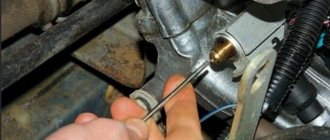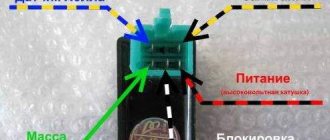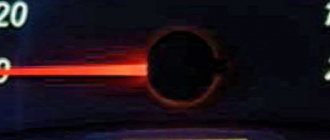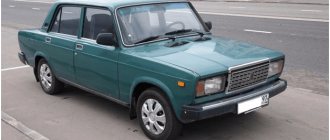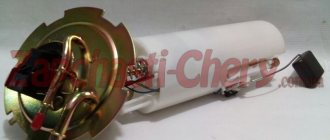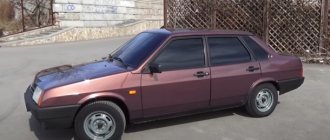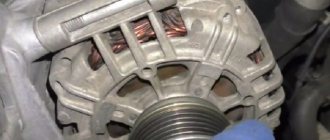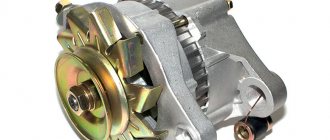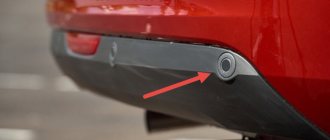To start the engine, you need to ensure that a spark appears at a certain moment to ignite the air-fuel mixture in the cylinders. Problems with starting the engine occur if one or more elements of the system malfunction. The table lists possible reasons why the Priora does not start.
If the Lada Priora's starter does not turn
| Possible malfunction | Diagnostics | Remedies |
| Low battery | The voltage at the battery terminals without load is less than 12V. When trying to start the engine, a cracking noise is heard from under the hood. | Charge the battery or replace it with a new one |
| Oxidation of battery terminals or wire terminals, their fit is not tight | When you try to start the car, the voltage in the on-board network drops much more than at the battery terminals. In this case, a crash may be heard under the hood. | Clean the contacts, lubricate them with petroleum jelly and tighten the terminals |
| The engine or attachments are jammed | Check the rotation of the crankshaft, pump and generator pulley. | Repair engine, generator, pump |
| The starter is faulty, the starter drive gear or flywheel ring teeth are damaged | Remove and inspect the starter. | Repair or replace starter |
| The starter switching circuit or starter relay is faulty, the wires are damaged, or the ignition switch contacts do not close | When the key is turned to position “II”, the starter traction relay does not operate (a click is not heard under the hood). Check the +12V supply to the control contact of the traction relay. | Replace starter relay, wires, ignition switch |
| The starter traction relay is faulty, there is a short circuit or break in the retractor winding, the relay armature is stuck | When the key is turned to position “II”, the traction relay does not operate (there is no click under the hood), but + 12V is supplied to the control contact of the traction relay. Remove the relay and check its operation. | Replace the traction relay |
| Contacts or wires of the traction relay are oxidized, poor ground contact | When the starter is turned on, a clicking sound is heard under the hood, but the starter armature does not rotate. Using an ohmmeter, check the resistance of the Battery-Starter circuit, as well as the ground wire. If the circuit is in good condition, remove the starter and check the operation of the traction relay by applying +12V to it from the battery | Tighten the terminals, clean the contacts, replace the traction relay |
| Open or short circuit in the holding winding of the traction relay | When you try to start the engine, you hear a crashing sound under the hood. The battery voltage is within normal limits. We check the traction relay with an ohmmeter or by its excessive heating. | Replace the traction relay |
| Burnt starter commutator, stuck brushes or severe wear Open or short circuit in the starter armature winding | The starter armature rotates slowly or does not rotate at all. Check the traction relay by applying voltage to the starter contact bolt directly from the battery | Replace starter or armature |
| Freewheel slipping | When the starter is turned on, the armature rotates, the flywheel is stationary | Replace clutch or starter |
Starter operating principle
This device itself is a conventional electric motor. A gear is installed on it, which meshes with the flywheel, which rotates when the power unit starts. A traction relay is also attached to the housing. The functions of this element include:
- gear movement control;
- starter disconnection.
When the key is turned to the starting position, voltage is supplied to the relay, exciting the electromagnet windings, then the contacts close. At the same time, the gear begins to rotate and the motor starts.
When the key is released, the voltage to the relay windings stops supplying and the contacts separate. The starter is accordingly turned off. This is, in general, the entire description of the operation of the node in question.
Priora won't start, starter turns
| Possible malfunction | Diagnostics | Remedies |
| There is no gasoline in the tank | On the instrument panel the fuel level indicator is at zero. | Pour gasoline |
| Battery is low | The voltage at the battery terminals without load is less than 12V. When trying to start the car, a crashing sound is heard from under the hood. | Charge the battery or replace it with a new one |
| Oxidation of battery terminals or wire terminals, their fit is not tight | When you try to start the engine, the voltage in the on-board network drops much more than at the battery terminals. In this case, a crash may be heard under the hood. | Clean the contacts, lubricate them with petroleum jelly and tighten the terminals |
| Unreliable connection of electrical circuits of engine control and power supply systems | Check the connections of the connectors and the reliability of the contacts in the blocks. | Fix faulty wire connections |
| Increased resistance to rotation of the crankshaft (scores on the shafts, bearing shells, cylinder-piston parts, deformation of the shafts, frozen engine oil, jammed generator, jammed coolant pump) | The crankshaft turns slowly. If the engine is started in severe frost, and the engine was working properly the day before, then most likely the engine oil has frozen. If you hear extraneous noise when starting the engine, check the free rotation of the pump and generator pulleys. | Use the recommended engine oil. Repair the engine. Replace the pump and generator. |
| Malfunction in the ignition system | Check for spark. | Check the circuits and devices of the ignition system. Replace faulty system elements. |
| The high voltage wires are connected in the wrong order or the wire is disconnected | Inspect. | Connect the wires in the correct order |
| The timing belt is broken or the belt teeth are cut off | Open the front timing cover and check. | Replace timing belt |
| Disturbed valve timing | Check the marks on the crankshaft and camshaft pulleys. | Set the correct shaft position |
| Malfunction of the computer (brains), its circuits, crankshaft position sensor or coolant temperature | Check the supply of +12V to the ECU, the sensor circuit, and the absence of damage to the sensors themselves. | Replace ECU, sensors. |
| The idle air regulator (IAC) or its circuits are faulty | Check the idle air control. When starting the engine, lightly press the gas pedal. If the engine starts and stalls when you release the gas pedal, the sensor is faulty. | Replace sensor |
| The fuse is blown or the main relay of the control system is faulty | Check fuse and relay. | Eliminate the cause of the blown fuse. Replace fuse and relay |
| Fuse blown, fuel pump relay. Circuit, relay or pump is faulty. | When the ignition is turned on, there is no sound of the pump running. Check the fuse. Apply voltage to the pump from the battery. | Clean contacts, replace faulty circuits, replace fuse, pump and relay. |
| The fuel filter is dirty, the water in the fuel line is frozen, the fuel line is damaged | Check the pressure in the fuel rail and the condition of the fuel lines. | Replace the filter, blow out or replace the fuel lines. |
| Insufficient pressure in the fuel rail | Check the pressure in the fuel rail, the pump strainer and the condition of the fuel lines. | Clean the filter. Replace pump, fuel pressure regulator |
| Faulty injectors or their power supply circuits | Check the injector windings with an ohmmeter. Check the chains for breaks. | Replace injectors, replace chains |
| Air leak into the intake tract | Inspect the joints and fittings of the hoses and clamps. During start-up, turn off the vacuum brake booster and plug the receiver fitting. | Eliminate air leaks, replace vacuum booster |
Features of mechanism diagnostics
How to diagnose a device to determine its performance:
- Before removing the terminals from the battery, you need to turn off the ignition. The terminals are disconnected to prevent damage to the powertrain controller.
- To get directly to the starter, you need to dismantle the air filter element housing with the inlet hose.
- Having reached the mechanism, you should unscrew the conductive cable, in particular, we are talking about the thickest wire connected to the positive terminal of the battery. It is fixed on the top stud of the solenoid relay; to remove it, use a 13 key. Remove the cable, then set the gearbox to neutral.
- Next, you will need a working battery; this is a prerequisite for diagnostics. If you are sure that your car is using a 100% working battery, then you can use it. Prepare a cable with alligator clips, connect it to the negative terminal of the battery, and the other end must be connected to the housing of the starter unit, in particular, to the bolt on it. Before direct connection, the connection point should be cleaned with a brush, this way you can ensure the best possible contact.
- After completing these steps, another cable with a crocodile must be connected to the positive terminal of the battery. And its other end needs to be connected to the plus located on the back of the mechanism.
- When connected, you should hear a click, indicating that the relay has activated. If there are no clicks, then it is necessary to diagnose the mass. Disconnect the wire from the housing and connect it to the bottom screw of the solenoid relay. Then the positive wire connected to the positive terminal again needs to be connected to the back of the device. If at this moment the solenoid relay still works, then most likely the problem lies in the failure of the brush assembly. If there are no clicks, that is, the relay did not work, then buy a new one and install it instead of the old one. The relay itself is not suitable for repair.
- At the next stage, the wire with the crocodile “-” will need to be connected to the housing again. And the cable connected to the positive terminal of the battery connects to the bottom screw on the relay. At the moment of connection, the starter device should begin to rotate, and a characteristic sound will be heard. If the mechanism operates in normal mode, its speed can reach 11 thousand per minute. If the device turns very slowly, then most likely the problem lies in the brush assembly or jammed armature, of course, if the car battery is working and the wire connection is correct. If the starter does not spin at all, then most likely the reason should be sought in the winding.
- To carry out a general check, the positive terminal must be connected to the upper stud of the relay, and then the contacts on this terminal and the “male” must be closed. If uncharacteristic sounds are heard when the starter is operating, check the gearbox or bendix.
Photo gallery “Do-it-yourself starter diagnostics”
1. Unscrew the conductive cable marked with the top arrow.
2. Connect the crocodile on the positive side of the battery to the “male” on the reverse side.
3. The negative wire from the battery is connected to the housing, and the positive wire is connected to the lower screw of the relay.
Lada Priora does not start when cold
- If the crankshaft rotates slowly, the battery may be discharged or the engine oil may be frozen.
- The vehicle's fuel system is faulty. The water in the ramp may have frozen.
- The coolant temperature sensor (DTOZH) of the engine management system is faulty.
- Fuel injectors are leaking.
- Low compression in cylinders.
- The engine control system is faulty. Run diagnostics.
How to remove the electric starter
The procedure in this case is as follows:
- remove the terminals from the battery;
- the “plus” connector is removed from the starter;
- removed from the relay block;
- The nuts securing the faulty unit are unscrewed.
Then you can safely remove it.
Next you will need to check the functionality of the relay. To do this, take emergency wires to start from another car. The negative one is installed on the battery and on the starter housing. “Plus” is connected to the relay. The latter in this case (if it works properly) is triggered and moves the gear. The absence of this reaction indicates a breakdown of this element.
If the Priora does not start well when hot
In this case, see the second table; in addition to the reasons described, also pay attention to:
- A pressure regulator that can discharge fuel through a membrane into the receiver.
- DPKV contacts, if the sensor has been changed, check that the poles are connected correctly.
- Faulty ignition module.
Let us remind you that in some cases the Priora does not start due to a faulty immobilizer or alarm system. In some cases, reflashing the engine ECU (electronic control unit) helps solve the problem of poor starting. And regular car maintenance will help eliminate problems of poor engine starting.
Keywords: Lada Priora engine | ignition system for Lada Priora | starter Lada Priora | power supply system for Lada Priora | ECM Lada Priora
+14
Share on social networks:
Found an error? Select it and press Ctrl+Enter..
Where is the relay located in Priora?
A car starter is a very reliable device and, as a rule, it is rare to find any problems with it. Often all problems occur in the starter relay. Many people are interested in the question, where is the relay located? On the Lada Priora it can be found in the fuse box, located in the car interior on the left side of the driver, near the module that controls the light.
Information about where the starter relay is located will be very useful to every car owner, since sometimes it is necessary to replace the starter fuse, and in Priora this happens regularly. In general, in the car we are considering, the electrical system as a whole is not the most reliable. Many Lada Priora owners note the poor quality of its work.
So, in order to gain access to the starter relay mechanism, you will need to remove the panel that actually hides the unit. The panel is secured with 5 fasteners. Carry out all work carefully.
Solenoid relay design
To understand how to identify a malfunction, you first need to understand the design and operating principle of the retractor relay, as well as the starter relay, since they are located in the same housing.
So, there is a housing, inside of which two coils are installed - retracting and holding.
On the one hand, the body is covered with an ebonite or plastic cover. Three terminals for connecting wiring are installed on the outside of this cover.
One of the terminals is intended for connecting the “positive” wire from the battery, the second is for supplying electricity to the starter motor, and the third is for connecting the relay to the ignition switch.
On the inside of the cover there are two contact plates of the “positive” terminals.
Schematic diagram.
Inside the housing with the coils there is an armature, spring-loaded on one side, and a starter relay rod.
On the outside of the armature there is an eyelet, with which it engages with the Bendix fork and gear.
